Why White Noise Womb Heartbeat Sounds Are Your Baby's Natural Sleep Solution
White noise womb heartbeat sounds combine the steady whoosh of intrauterine noise with the rhythmic pulse of a mother's heart - creating the exact acoustic environment your baby knew for nine months. This powerful combination helps explain why research shows 80% of newborns fall asleep within five minutes when exposed to these familiar sounds, compared to just 25% without them.
Quick Answer: What You Need to Know
- What it is: White noise mixed with heartbeat rhythms that mimic womb sounds
- Why it works: Recreates the 70-90 dB sound environment babies heard before birth
- Proven results: Studies show faster sleep onset, lower heart rates, and better weight gain
- Safe usage: Keep volume under 50 dB and place devices away from baby's head
- Best for: Newborns to 18 months, especially helpful for preterm infants
The science is clear. In controlled studies, premature infants exposed to maternal heartbeat combined with white noise showed significantly improved vital signs - heart rates dropped from 149 to 129 beats per minute, and weight gain increased by over 2 grams per kilogram daily. These aren't just numbers on a chart. They represent calmer babies, better sleep, and much-needed relief for exhausted parents.
The transition from womb to world is jarring for newborns. Inside the uterus, babies are surrounded by constant sound - blood rushing through vessels, digestive gurgles, and the steady thump of mom's heart. Suddenly, they're expected to sleep in comparative silence. No wonder they fuss.
I'm Gary Harutyunyan, and after struggling with my own newborn's sleep challenges, I created the Sleepy Baby device specifically to combine white noise womb heartbeat sounds with gentle rhythmic patting. My experience as a father and my background managing complex state projects taught me that sometimes the simplest solutions - like recreating what babies already know - work best.
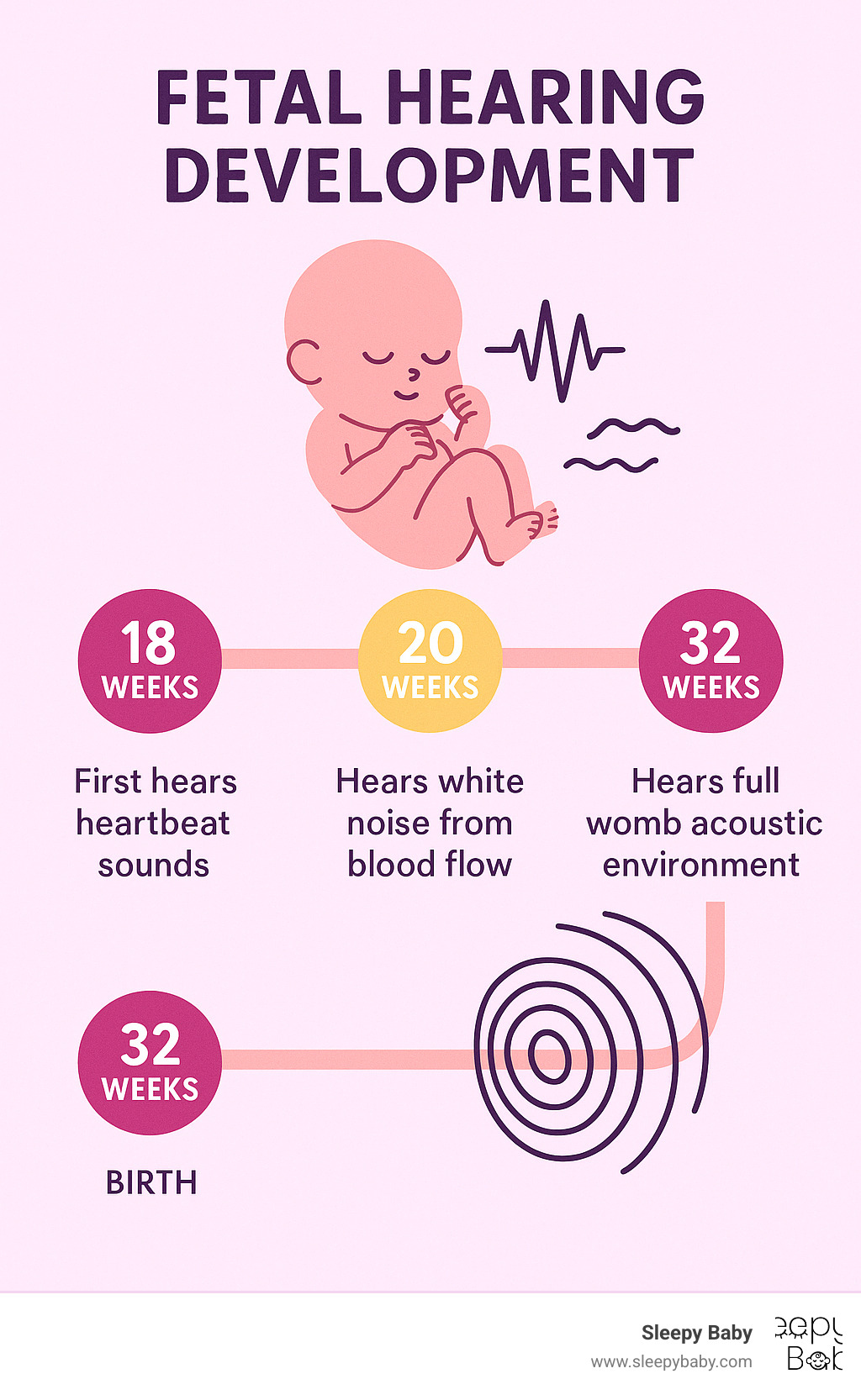
What Is White Noise, the Womb & the Heartbeat Connection?
Your baby's love affair with white noise womb heartbeat sounds didn't start at birth - it began months before they ever saw your face. To understand why these sounds work like magic on fussy newborns, we need to peek inside the womb and find what your little one was listening to all along.
White noise is essentially every sound frequency mixed together at equal volume. Think of the steady hum of a fan, the whoosh of a hair dryer, or the gentle rush of rainfall. But here's the fascinating part: the womb naturally creates its own version of white noise, complete with the rhythmic soundtrack of your heartbeat.
The womb is anything but quiet. Recent studies using sensitive recording equipment reveal that babies experience a constant acoustic environment measuring 70-90 decibels - that's louder than your dishwasher and about as noisy as a busy coffee shop. Your baby spent nine months in this sound-rich environment, so the sudden silence of the outside world can feel downright unsettling.
The Physics Behind the "Shhh"
The real genius of white noise womb heartbeat combinations lies in something called broadband masking. When that dog barks outside or your toddler drops a toy, these sudden noises get absorbed into the steady background hum instead of startling your sleeping baby. It's like having a sound bodyguard that catches disruptive noises before they can wake your little one.
The frequency range matters too. True white noise covers the full spectrum from 20 Hz to 20,000 Hz, but the most soothing effects happen in the lower frequencies where heartbeat sounds live. This is why combining white noise with heartbeat rhythms creates such a powerful sleep trigger for babies.
How the Uterus Sounds From the Inside
What makes authentic womb sounds so special isn't just the volume - it's the unique mix of sounds your baby heard every single day before birth. Scientific research on real womb recordings has captured this intrauterine symphony in remarkable detail.
Your heartbeat was your baby's first lullaby, providing a steady rhythm of 60-100 beats per minute that became deeply familiar and comforting. But it wasn't alone in this acoustic landscape. The whoosh of blood flowing through your major vessels created a constant rushing sound, while your digestive system contributed gentle gurgles and pops.
Even your breathing played a part, adding its own gentle rhythm to the mix. Your body acted as a natural sound filter, softening harsh outside noises while allowing comforting low-frequency sounds to reach your baby. This is why authentic womb recordings sound warm and muffled rather than sharp or jarring.
The amniotic fluid itself changed how sound traveled, creating that distinctive underwater quality that makes real womb sounds so different from regular white noise. When blood pulsed through your vessels, it created pressure waves that your baby felt as much as heard, adding a physical dimension to the auditory experience.
This complex soundscape became your baby's definition of safety and comfort. No wonder recreating these familiar white noise womb heartbeat patterns can transform a crying infant into a peacefully sleeping one in just minutes.
White Noise Womb Heartbeat: Proven Benefits for Babies
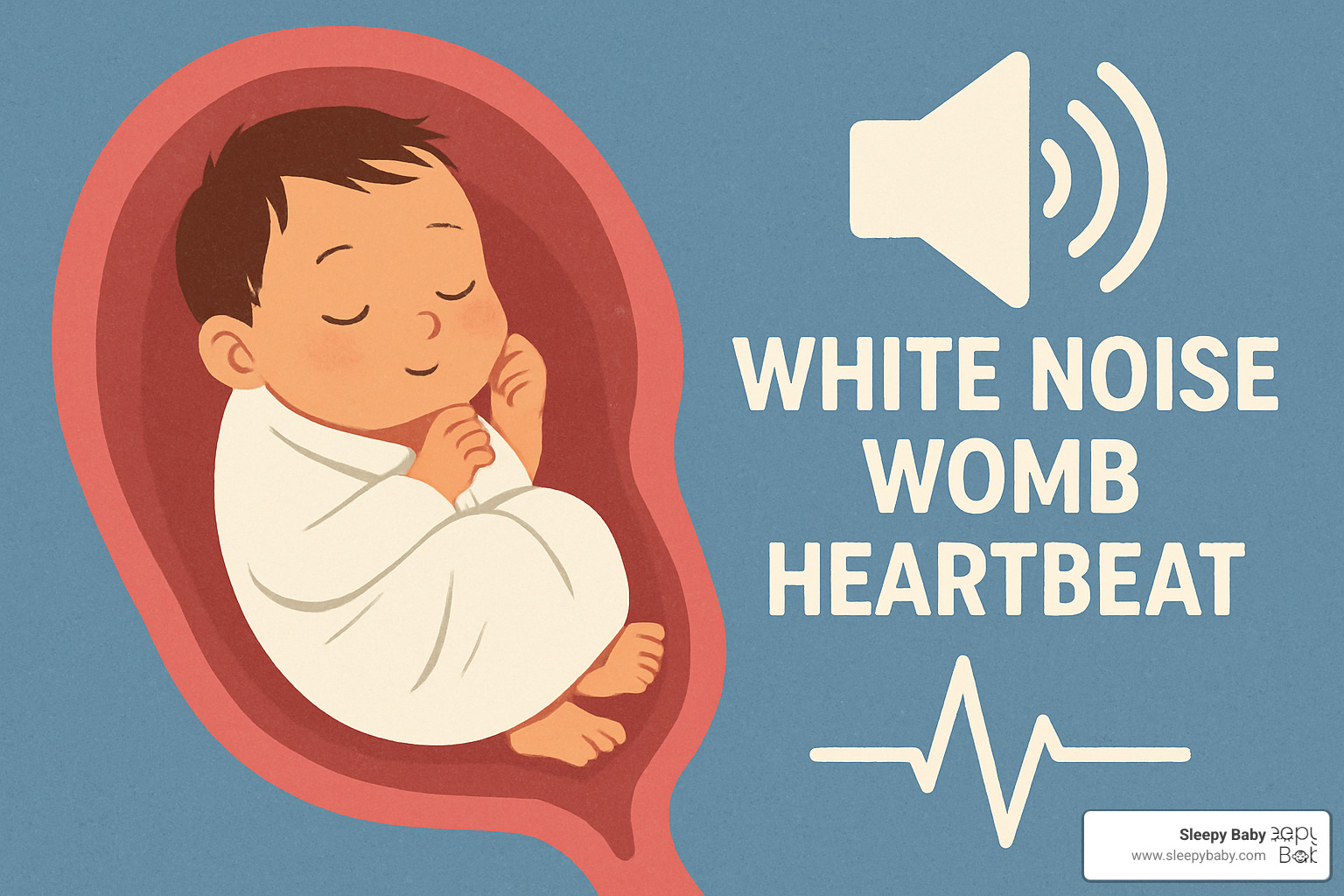
The research on white noise womb heartbeat benefits isn't just impressive - it's transformative for understanding infant care. Multiple studies across different populations consistently show that recreating womb acoustics provides measurable benefits for babies' sleep, growth, and overall wellbeing.
Why 80% of Newborns Fall Asleep in 5 Minutes
The landmark 1990 study published in Archives of Disease in Childhood remains one of the most cited pieces of research on infant sleep. Researchers tested 40 newborns aged 2-7 days, exposing half to white noise while the control group experienced normal nursery conditions. The results were striking: 16 out of 20 babies (80%) in the white noise group fell asleep within five minutes, compared to just 5 out of 20 (25%) in the control group.
But why does this work so reliably? The answer lies in what researchers call the "calming reflex." When babies hear familiar womb-like sounds, their nervous systems recognize the acoustic environment and automatically shift into a more relaxed state. Their heart rates slow, muscle tension decreases, and sleep comes naturally.
More recent studies using the Anderson Behavioral State Scale have quantified this effect even further. Premature infants exposed to white noise womb heartbeat combinations showed sleep scores improving from 4.77 to 1.38 within 20 minutes - a dramatic shift from agitated wakefulness to peaceful sleep.
Beyond Sleep: Growth & Neurodevelopment Gains
Perhaps the most remarkable findings come from studies on premature infants in NICUs. When researchers combined maternal heartbeat recordings with white noise and played them for preterm babies, the results went far beyond improved sleep:
Weight Gain: Infants in the intervention group gained weight significantly faster - 12.04 grams per kilogram per day compared to 9.97 grams per kilogram in the control group. This 20% improvement in weight gain velocity can make the difference between extended NICU stays and going home with parents.
Feeding Success: Daily milk intake increased dramatically from 213.82 mL to 280.44 mL after 14 days of sound intervention. Better feeding directly correlates with faster growth and neurological development.
Cardiovascular Stability: Heart rates stabilized at healthier levels, dropping from an average of 148.3 beats per minute to 130.36 beats per minute during and after sound exposure.
Subtypes Compared: Static, Shushing, Heartbeat Tracks
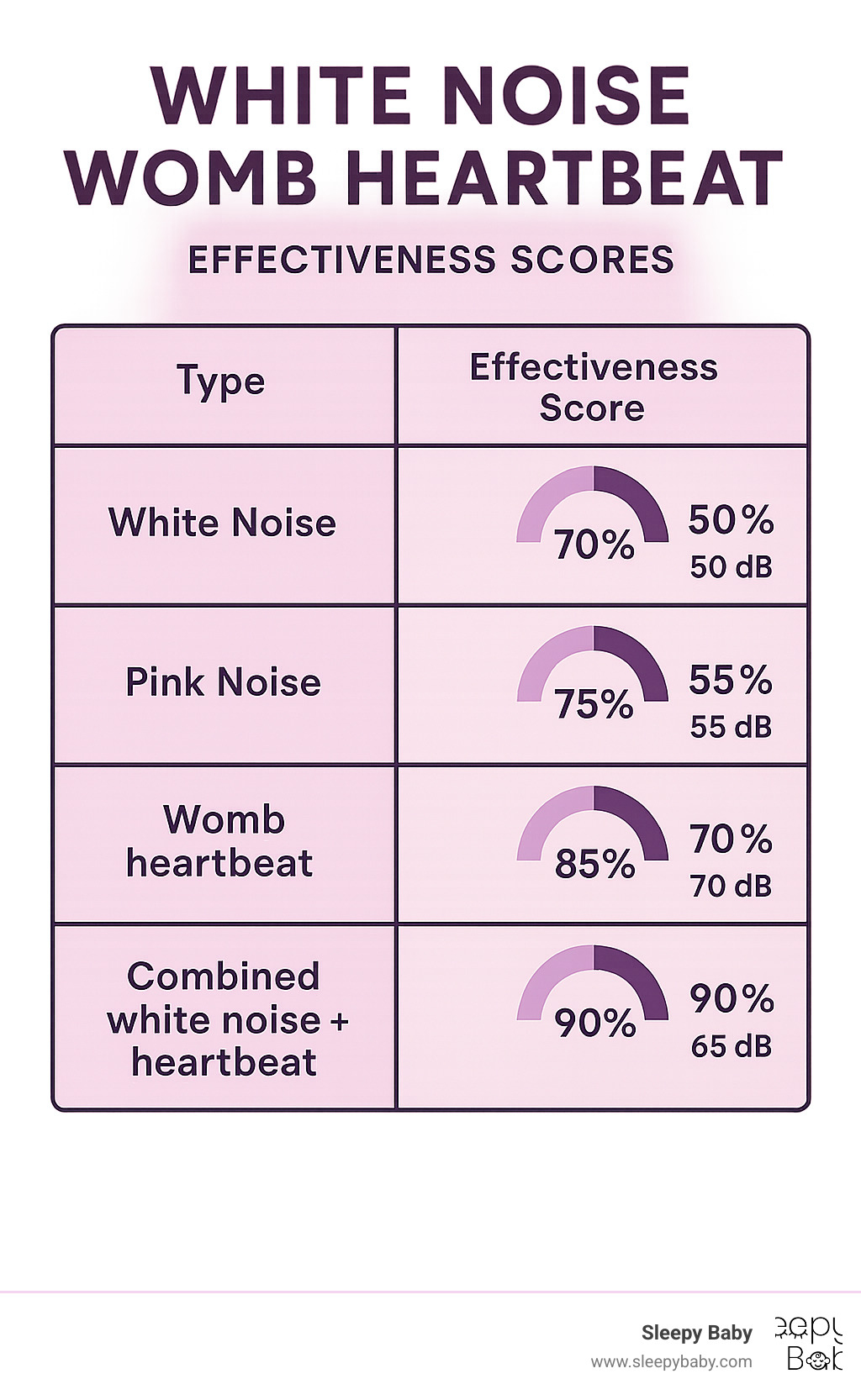
Not all sounds marketed as "womb-like" are created equal. Our analysis of different sound types reveals important distinctions:
Pure White Noise: Effective for masking sudden sounds but lacks the rhythmic comfort of heartbeat patterns. Works well for older babies (4+ months) who need consistent background noise.
Shushing Sounds: Technically a form of white noise, the human "shhh" sound activates the calming reflex effectively. However, recorded shushing can sound artificial and may not provide consistent volume.
Heartbeat-Only Tracks: Provide rhythmic comfort but lack the broadband masking effect needed to block environmental noise. Best used in already quiet environments.
Combined White Noise + Heartbeat: Research shows this combination provides the most comprehensive benefits, offering both acoustic masking and rhythmic comfort. This is why our Sleepy Baby devices integrate both elements.
Safe Volume, Duration & Real-World How-To
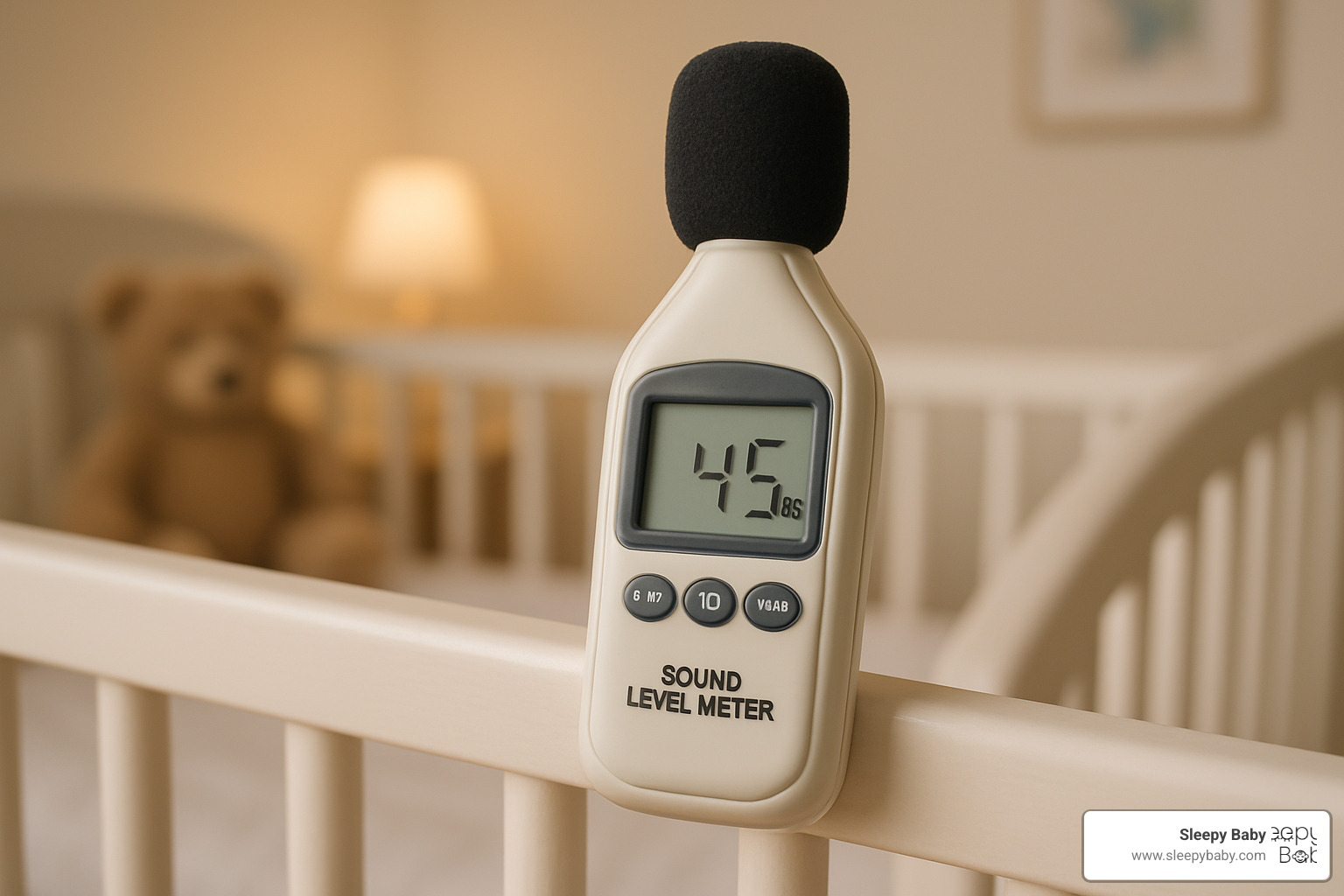
When it comes to white noise womb heartbeat sounds, safety isn't just important - it's everything. Yes, your baby heard 70-90 decibels in the womb, but those tiny ears are much more vulnerable now that they're no longer protected by amniotic fluid.
The golden rule is simple: keep volume below 50 decibels. That's about as loud as a quiet conversation between friends. If you need to raise your voice to talk over the sound, it's too loud for your baby.
Distance matters just as much as volume. Place your sound device at least three feet away from your baby's head. Here's a parent-tested trick: download a free decibel meter app on your phone. Hold it where your baby's head will be and check the reading. Most parents are surprised to find their "quiet" white noise is actually much louder than they thought.
Creating a Womb-Like Oasis at Home
The magic happens when you combine white noise womb heartbeat sounds with other womb-like conditions. Your baby spent nine months in a specific environment, and recreating those conditions works better than sound alone.
Darkness is your friend. The womb was essentially a blackout room, so invest in good blackout curtains. Temperature control makes a huge difference too. Keep the nursery between 68-70°F - warm enough to feel cozy but cool enough to prevent overheating.
Timing your routine around these elements creates powerful sleep associations. Start your wind-down ritual the same way each time: dim the lights, begin the white noise, swaddle your baby, and let the familiar sounds work their magic.
Our Sleepy Baby device was designed with this holistic approach in mind. We don't just play sounds - we combine white noise womb heartbeat audio with gentle rhythmic patting that mimics a parent's comforting touch. More info about x services
Guidelines for NICU & Clinical Use
Healthcare settings require extra precision when using white noise womb heartbeat interventions. Volume calibration in clinical settings should target 35-45 decibels - slightly quieter than home use because NICU babies are typically more sensitive.
Timing protocols work best when coordinated with the NICU's developmental care schedule. Many units find that playing womb sounds during quiet periods improves the overall calming environment for all babies in the ward.
The research backing clinical use is solid. Multiple randomized controlled trials show that premature infants exposed to maternal heartbeat combined with white noise have better vital signs, improved feeding, and faster weight gain. These aren't just statistics - they represent babies going home to their families sooner.
When & How to Wean Off the Soundtrack
Most babies naturally outgrow their need for constant white noise womb heartbeat sounds somewhere between 3-4 months. Their sleep patterns mature, and they develop new comfort associations. The key is making this transition gradually rather than going cold turkey.
Start with timing changes rather than volume changes. If you've been playing sounds all night, try using a timer to turn them off after your baby falls asleep. Volume fading comes next. Once your baby is comfortable with timed sessions, begin reducing the volume by small increments every few days.
Sleep associations evolve naturally as babies grow. What worked at 2 months may feel overwhelming at 6 months. Pay attention to your baby's cues - if they seem startled by sounds that used to comfort them, it might be time to dial things back.
Scientific research on hazardous outputs reminds us why gradual transitions matter. Sudden changes in a baby's sleep environment can trigger regression and disrupt the very sleep patterns you've worked so hard to establish.
Choosing & Comparing Devices and Apps
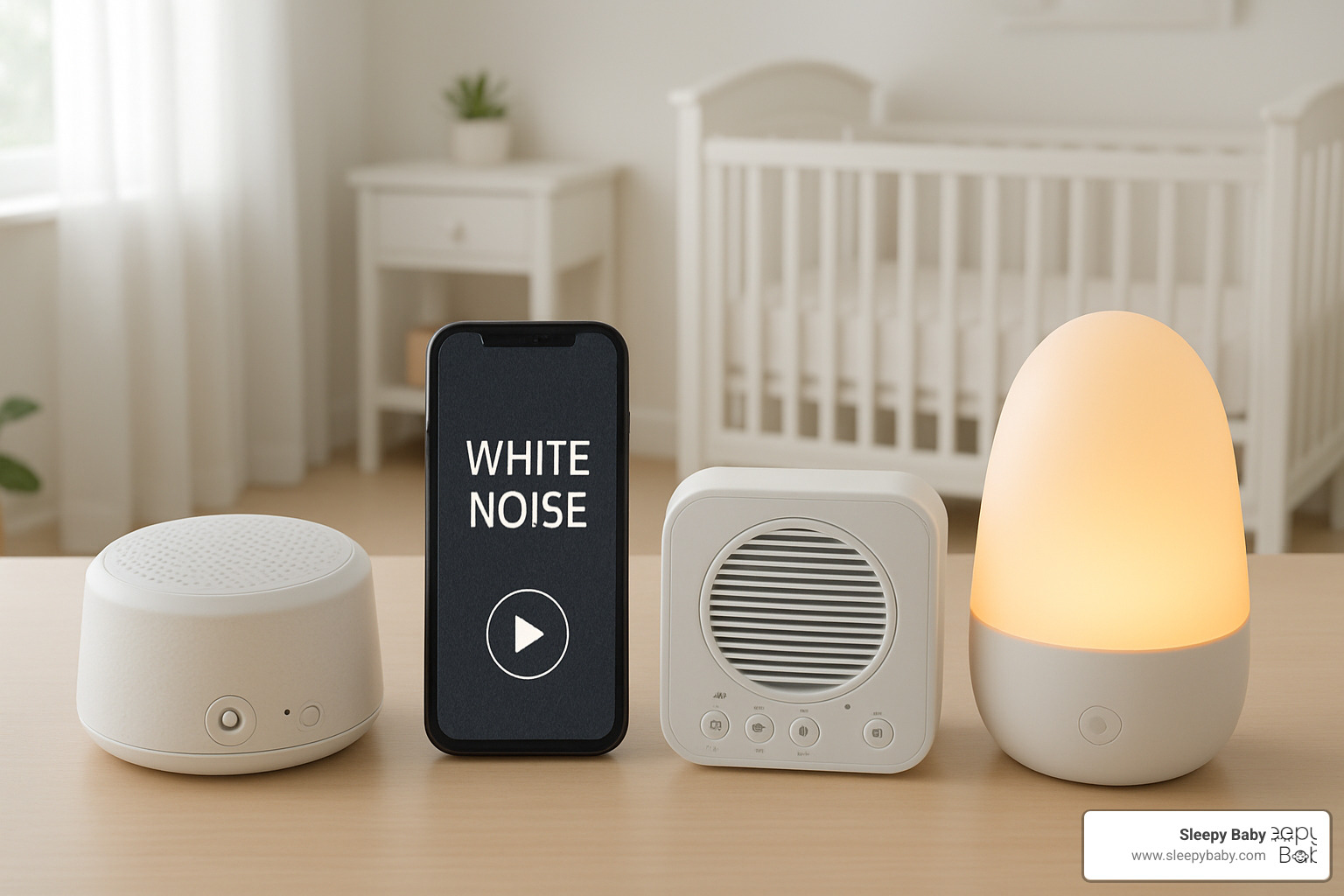
Walking down the baby aisle can feel overwhelming when you're faced with dozens of devices all promising to solve your sleep struggles. The white noise womb heartbeat market has grown rapidly, but here's the truth - not all devices are created equal. After countless sleepless nights with my own baby, I learned that the difference between a $15 app and a quality device can mean the difference between two hours of sleep and eight.
The biggest mistake parents make is thinking any white noise will work. I've seen families cycle through three or four different devices before finding one that actually helps. Understanding what makes an effective white noise womb heartbeat device saves you time, money, and precious sleep.
Must-Have Features for Parents
Audio quality separates the winners from the wannabes. Your baby needs true white noise - that consistent whoosh that sounds like a vacuum cleaner or hair dryer. Skip devices that only offer nature sounds, lullabies, or "relaxing" music. These might sound prettier to adult ears, but they don't provide the steady acoustic blanket that calms babies.
Precise volume control isn't just convenient - it's essential for safety. Devices with only three volume settings rarely hit that sweet spot between effective and safe. You need the ability to fine-tune the sound to stay under 50 decibels while still providing comfort.
Loop-free audio might seem like a technical detail, but it makes a huge difference. Cheap devices often use 30-second recordings that repeat with noticeable gaps or sudden restarts. These interruptions can jolt a baby awake just as they're drifting off. Quality devices use longer recordings or smart technology to create seamless soundscapes.
Timer flexibility becomes important as your baby grows. Newborns often need continuous sound, but older babies benefit from devices that turn off after they fall asleep. Look for options that include 30-minute, 60-minute, and all-night settings.
True portability means your baby's sleep routine travels with you. The best sleep associations are consistent ones. Whether you're visiting grandparents, taking a vacation, or just moving from room to room, your device should maintain the same comforting sounds your baby expects.
Our Sleepy Baby devices combine all these essential features with something unique - rhythmic patting that works alongside white noise womb heartbeat sounds. This creates a complete womb experience that goes beyond what sound-only devices can offer. More info about x services
Verifying "Real" Womb Heartbeat Quality
Marketing claims about "authentic womb sounds" vary wildly in accuracy. Real white noise womb heartbeat recordings have specific characteristics that make them more effective than synthetic approximations.
Natural rhythm variation is the first clue to authenticity. Real maternal heartbeats naturally fluctuate slightly in timing and intensity - they're not perfectly metronomic. If a heartbeat track sounds too regular or mechanical, it's probably artificially generated.
Low-frequency richness distinguishes authentic recordings from cheap imitations. Inside the womb, maternal tissue naturally filters harsh high frequencies while allowing comforting low tones to reach the baby. Authentic recordings should sound warm and muffled rather than sharp or tinny.
Complex sound layering separates real womb recordings from simple heartbeat tracks. Authentic intrauterine audio includes multiple elements - the rhythmic heartbeat, whooshing blood flow, gentle digestive sounds, and filtered external noise. Single-element tracks miss the rich acoustic environment babies actually experienced.
When testing devices, trust your ears. If a heartbeat sounds like it was created on a computer rather than recorded from a real mother, it probably was. The most effective sounds feel organic and naturally soothing.
Adults & Older Kids: Can They Benefit Too?
The benefits of white noise womb heartbeat sounds extend surprisingly far beyond infancy. Research shows that adults exposed to consistent background noise experience deeper sleep and better memory consolidation. It turns out our brains never completely outgrow the comfort of steady, predictable sounds.
Older children often refind the benefits of womb-like sounds during challenging periods. Starting a new school, moving to a different home, or dealing with family stress can trigger sleep disruptions that respond well to familiar acoustic comfort. Some children with attention challenges also find that gentle background noise helps them focus during homework or quiet activities.
Adults dealing with tinnitus frequently report that white noise provides relief from ringing ears, especially during sleep. The masking effect that helps babies ignore sudden household noises works equally well for adults trying to ignore their own internal ear sounds.
Shift workers and light sleepers benefit from the sound-masking properties that make daytime sleep possible despite neighborhood noise. The same broadband acoustic blanket that protects baby sleep works for adults trying to rest during busy daylight hours.
The key difference is that adults and older children should view white noise as a tool rather than a dependency. Unlike newborns who genuinely need womb-like comfort during their fourth trimester, older family members benefit most when they use these sounds strategically rather than habitually.
Frequently Asked Questions about White Noise Womb Heartbeat
Does using white noise delay auditory development?
This worry keeps many parents up at night (ironically, the opposite of what we want!). The good news? Current research shows that white noise womb heartbeat sounds don't interfere with normal hearing development when used safely.
Studies following infants who regularly used white noise devices found completely normal auditory processing development - as long as parents kept volume levels reasonable (under 50 dB). Think about it this way: your baby spent nine months listening to sounds in the womb that were actually louder than most nursery sound machines.
Some researchers even suggest that appropriate sound exposure might support auditory development by giving your baby's developing brain consistent acoustic input to process. The key word here is "appropriate" - we're talking about gentle, consistent background noise, not rock concert levels.
The real risk comes from very loud sounds used continuously. But when you follow safety guidelines and use quality devices properly, you're actually recreating the natural sound environment your baby expects.
How loud is too loud for a nursery sound machine?
Here's where many parents get surprised - some commercial sound machines can reach 85 decibels or higher. That's vacuum cleaner territory, and definitely too loud for your baby's sensitive ears.
The American Academy of Pediatrics gives us a clear guideline: keep nursery sounds below 50 decibels measured at your baby's ear level. To help you picture this, 50 dB is about as loud as a normal conversation in your living room. At 40 dB, you're in quiet library range.
The tricky part is that decibel levels change dramatically with distance. A device that measures 50 dB at three feet might hit 70 dB right next to your baby's head. That's why placement matters just as much as volume settings.
Here's a simple test: if you can comfortably have a conversation over the white noise without raising your voice, you're probably in the safe zone. Even better, grab a smartphone app that measures decibels and check the actual levels where your baby sleeps.
Should I keep it on all night or only at bedtime?
This question touches on one of the biggest differences between newborns and older babies. For your fresh-from-the-womb newborn (0-4 months), continuous white noise womb heartbeat sounds throughout the entire sleep period work best.
Your baby just spent months in an environment that never got quiet. The womb doesn't have an off switch. Keeping gentle sounds playing all night helps your newborn stay asleep through those natural light-sleep periods that happen every 45-60 minutes.
But as your baby grows and their sleep patterns mature (around 4-6 months), you can start using timer functions. This gradual approach helps prevent your little one from becoming completely dependent on sound to sleep.
Think of it as a gentle transition from the womb world to the real world. You're not taking away comfort - you're helping your baby develop the confidence to sleep in slightly quieter environments as they grow.
The beauty of devices like our Sleepy Baby system is that they give you the flexibility to adjust both sound and movement as your baby's needs change, supporting natural sleep development every step of the way.
Conclusion
The journey from womb to world doesn't have to be jarring for your little one. White noise womb heartbeat sounds offer a bridge between the familiar acoustic cocoon your baby knew for nine months and the surprisingly quiet world they've entered. When 80% of newborns fall asleep within five minutes of hearing these familiar sounds, we're not just seeing statistics - we're witnessing the power of giving babies what they already know and love.
The research tells a compelling story. Faster sleep onset, improved weight gain, better feeding, and more stable heart rates aren't just clinical outcomes. They translate into real relief for exhausted parents and healthier development for babies during those crucial early months. When premature infants in NICUs show such dramatic improvements from simple sound interventions, it reminds us that sometimes the most effective solutions are also the most natural ones.
At Sleepy Baby, we've taken this science one step further. Our devices don't just recreate the sounds of the womb - they combine white noise womb heartbeat audio with gentle rhythmic patting to simulate the complete comfort experience your baby remembers. It's like having an extra pair of hands when you need them most, providing consistent soothing that helps both babies and parents get the rest they desperately need.
Every baby is beautifully unique. What sends one little one into peaceful slumber might take some adjustment for another. Start with safe volume levels below 50 decibels, position devices away from your baby's head, and pay attention to how your little one responds. The goal isn't creating a dependency but rather easing that monumental transition from the warm, noisy womb to the big, quiet world.
Think of womb sounds as your baby's first lullaby - one they've been listening to since before they were born. By honoring what they already know and love, you're not just promoting better sleep. You're supporting their natural development, reducing stress for the whole family, and building the foundation for healthy sleep habits that will serve them well beyond those precious newborn days.
Sweet dreams are waiting for both of you. Sometimes all it takes is remembering that the most powerful comfort comes from the familiar rhythm of home - the first home your baby ever knew.



